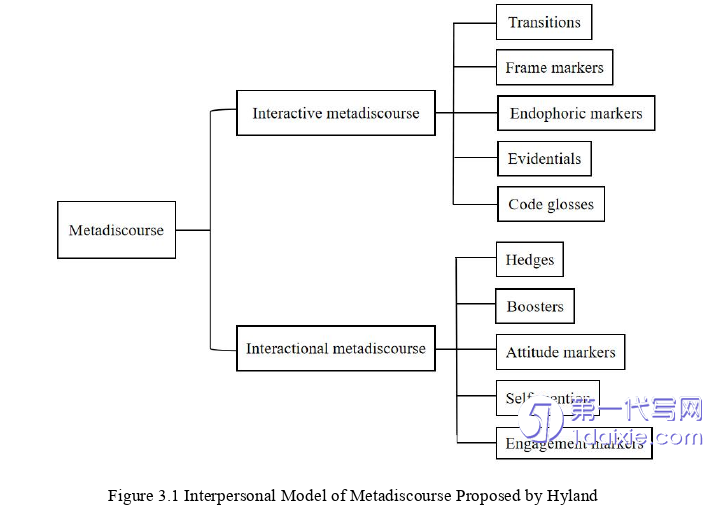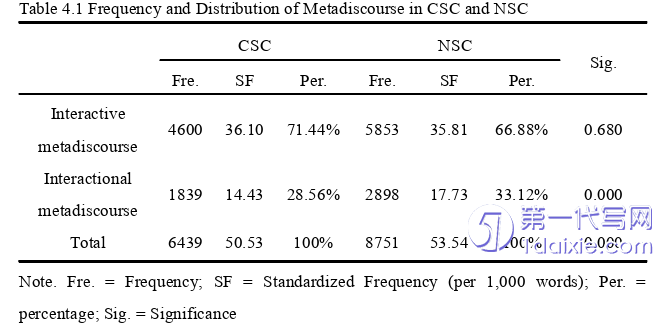本文是一篇英语论文,本研究探讨了CSC和NSC在通过元话语实现修辞诉求方面的异同及其影响因素。根据microsoftofficeexcel选择的40篇英语研究文章,构建了两个语料库(CSC和NSC),总字数为290891个词,以完成这三个研究问题。在仔细手动注释后,借助AntConc 3.5.8和IBMSPSS统计数据26探索了研究目标。这里,将根据第一章中提出的三个研究问题依次介绍主要发现。
Chapter One Introduction
1.1 Research Background
Academic journals have the function of spreading excellent culture and promotinghuman progress(Chen&Su,2008).After implementing the reform and opening policyin 1978,China witnesses a rapid development of English journal publishing with thedevelopment of the economy and academic prosperity(Ding&Miao,2020).Whileacademic internationalization is becoming a hot issue in the Chinese academiccommunity,it is also becoming an unstoppable trend(Wang&Yang,2013).
Being widely used in international interaction and cooperation,English is not onlydominant in diplomacy,international conferences and trade but also plays a crucial rolein academic publishing(Wang&Yang,2013).Swale(1985)points out that the majorityof research articles produced each year are written in English,and English is increasinglybecoming an academic lingua franca(Mauranen,Hynninen&Ranta,2016).Therefore,numerous scholars from non-English-speaking countries publish English research articlesto spread their culture and achievements to realize international academic exchanges,andChina is no exception(Lu,2015).In other words,domestic scholars’publication ofEnglish journals is an effective way for China to promote Chinese culture and occupy theright of speech in the international academic community.

1.2 Research Questions
Adopting the interpersonal model of metadiscourse proposed by Hyland(2005a)and Aristotle’s(1991)rhetorical persuasion theory,this research aims to explore thepersuasive function of metadiscourse in research articles and similarities and differencesin using metadiscourse to realize rhetorical appeals in English research articles written bynative English scholars and Chinese scholars.Therefore,three research questions areproposed as follows:
1)What are the distribution characteristics of metadiscourse in English researcharticles written by Chinese scholars and native English scholars?
2)What means of persuasion are realized by metadiscourse in the two corpora?
3)What are the similarities and differences between the two corpora in realizingmeans of persuasion through metadiscourse and the influencing factors?
Chapter Two Literature Review
2.1 Previous Studies on Research Articles in Linguistics
Academic discourse refers to the ways of thinking and using language in theacademic community,which plays a pivotal role in disseminating thoughts,constructingknowledge,promoting the development of the university system,and constructingacademic identity(Hyland,2009).As a central element of academic discourse,researcharticle has a long history in knowledge creation.It is derived from the informative letterspublished in the first scientific journal(i.e.,The Philosophical Transactions)establishedby The Royal Society in 1665(Hyland,2009).Because of the peer-review mechanismand the nature of describing science,research article is considered an influential front forknowledge creation in the academic community.Given the significance of researcharticles in academic and educational circles,numerous scholars have researched differentcharacteristics of research articles.This section will mainly summarize previous studieson the structural and linguistic features of research articles.
2.1.1 Previous studies on structural features of research articles
In general,previous studies on the structure of research articles primarily focus onthe overall structure and structure of specific sections.This part will summarize relatedresearch according to the research content.As a representative to study generic structurefrom the perspective of English for Specific Purposes,Swales(1990;2004)proposes theIMRD(Introduction-Methods-Results-Discussion)and CARS(Create a Research Space)model.Those two models have been widely employed by scholars in examining thegeneric structure of research articles and have become an essential basis for future studies(Xu,2013).
2.2 Previous Studies on Metadiscourse
Metadiscourse refers to the ways writers guide readers through the text.Since ZelligHarris initially coined it in 1959,it has been explored by numerous scholars.With thejoint effort of analysts interested in metadiscourse,the concept becomes more practicallyapplicable.This section will summarize previous studies on metadiscourse in spoken andwritten discourse,respectively.
2.2.1 Metadiscourse in spoken discourse
Although Mauranen(2010)claims that metadiscourse plays a more significant rolein spoken discourse than written discourse,the extant research on metadiscourse stillfocuses on written discourse.However,it should be pointed out that some scholars havestarted to pay attention to metadiscourse in the spoken context in recent years.
Studies on metadiscourse in spoken discourse mainly focus on the school context,examining teachers’use of metadiscourse in lectures or classes.For example,Lee andSubtirelu(2015)conduct a corpus-based comparative study to examine the employmentof metadiscourse in English for Academic Purposes lessons and academic lectures.Theyfind that teachers’use of metadiscourse is affected by some aspects of teaching andlearning.Teachers in lessons and lectures prefer to employ metadiscourse according tothe features of their current situation.Moreover,Guo and Lu(2020)examine theemployment of metadiscourse by English teachers of native Chinese speakers andEnglish teachers of native English speakers.The findings suggest that there is nosignificant difference in meta-talk between the two groups of teachers.
Chapter 4 Findings and Discussion
4.1 Frequency and Distribution of Metadiscourse in CSC and NSC
This section will present the frequency and distribution of metadiscourse in CSCand NSC,including the overall distribution of metadiscourse and the distribution ofinteractive and interactional metadiscourse in CSC and NSC.
4.1.1 Overall distribution of metadiscourse
Table 4.1 presents the overall distribution of metadiscourse in CSC and NSC and thechi-square test results between the two corpora.It should be noted that if the significancevalue is lower than 0.05,there is a significant difference between the two groups of data.
In brief,metadiscourse resources are widely employed in both CSC and NSC.Thereare 6439 metadiscourse markers in CSC with a standardized frequency per 1,000 wordsof 50.53,while NSC uses 8751 metadiscourse markers in total,and the standardizedfrequency per 1,000 words is 53.54.The chi-square test result shows a significantdifference in the total frequency of metadiscourse between CSC and NSC(Sig.=0.000<0.05).Specifically,concerning the employment of interactive metadiscourse,CSC has araw frequency of 4600 with a standardized frequency of 36.10,while 5853 interactivemetadiscourse markers are identified in NSC with a standardized frequency per 1,000words of 35.81.Meanwhile,no significant difference is detected in the frequency ofinteractive metadiscourse between the two corpora(Sig.=0.680>0.05).In terms ofinteractional metadiscourse markers,a total of 1839 cases are found in CSC with astandardized frequency of 14.43,while NSC uses 2898 cases with a standardizedfrequency of 17.73.Furthermore,the statistical analysis shows that NSC employssignificantly more interactional metadiscourse markers than CSC(Sig.=0.000<0.05).

Chapter Five Conclusion
5.1 Major Findings
Adopted Hyland’s(2005a)interpersonal model of metadiscourse and Aristotle’s(1991)rhetorical persuasion theory,this thesis conducts a comparative study on thepersuasive function of metadiscourse in English research articles written by Chinesescholars and native English scholars.Specifically,this study examines the distributioncharacteristics and persuasive function of metadiscourse in English research articles byChinese and native English scholars.Meanwhile,this study also explores the similaritiesand differences in realizing rhetorical appeals through metadiscourse between CSC andNSC and the influencing factors.Depending on 40 English research articles selected byMicrosoft Office Excel,two corpora(CSC and NSC)with an aggregate number of290,891 words are built to accomplish the three research questions.After careful manualannotation,the research objectives are explored with the help of AntConc 3.5.8 and IBMSPSS Statistics 26.Here,the major findings will be presented sequentially according tothe three research questions proposed in Chapter One.
First,metadiscourse markers are ubiquitous in both CSC and NSC.Specifically,interactive metadiscourse is used more frequently than interactional metadiscourse in thetwo corpora.There is no significant difference in the employment of interactivemetadiscourse between the two corpora.However,NSC employs significantly moreinteractional metadiscourse markers than CSC.The preference of metadiscourse ofChinese scholars is as follows:In terms of interactive metadiscourse,transitions rank first,followed by evidentials,code glosses,frame markers,and endophoric markers;as forinteractional metadiscourse,hedges are used most frequently,followed by boosters,attitude markers,self-mention,and engagement markers.Meanwhile,the distributioncharacteristics of metadiscourse in English research articles by native English scholarsare as follows:In terms of interactive metadiscourse,transitions have the highestfrequency in NSC,followed by code glosses,evidentials,frame markers,and endophoric markers;in the aspect of interactional metadiscourse,hedges are used most frequently,followed by self-mention,boosters,attitude markers,and engagement markers.Furthermore,Chinese scholars employ significantly more endophoric markers and framemarkers than native English scholars,while native English scholars employ significantlymore code glosses,attitude markers,self-mention markers,and engagement markers thanChinese scholars.
reference(omitted)
